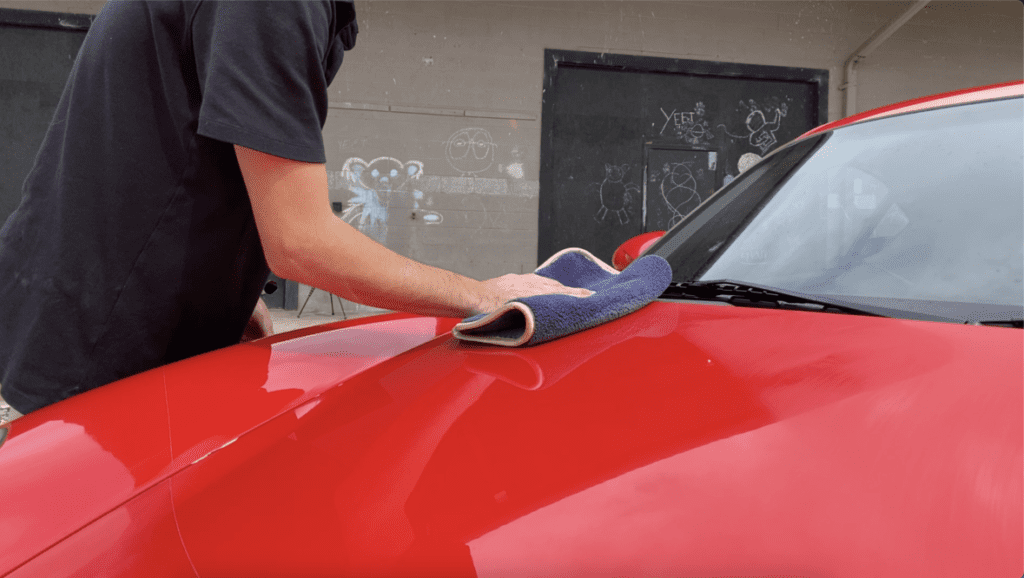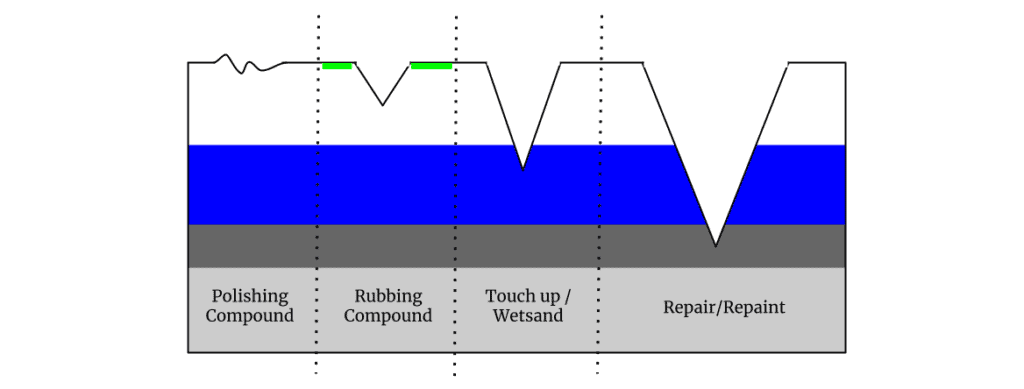
Using rubbing compound on your car can remove scratches and micro swirls in your paint, making your car look shinier. Should you compound your car all the time? Is there potential harm in over-polishing your car?
When using rubbing compound on a car burning through the clear coat is the biggest worry. This occurs when you remove too much clearcoat, exposing the bare paint. This can leave dull spots on the paint or even expose primer or bare metal. As long as you are careful not to burn through your car’s clear coat it is safe to polish your car’s paint.
Want to know more about rubbing compounds and preventing burning through your paint? Keep reading to learn everything you need to know before polishing your car!
What Harm Could Rubbing and Polishing Compound Cause?
Rubbing and polishing compounds are abrasives that remove imperfections in the clear coat, bringing the top layer of the clear coat with it. Rubbing compound typically has a higher grit than polishing compound, meaning it takes off more of the clear coat and imperfections. Polishing a car aims to remove as many defects as possible while leaving as much clearcoat as possible. This can be done by assessing how deep the clear coat scratches are and choosing the right compound accordingly.

When polishing either by hand or with a machine, you need to be careful around any high spots. Including:
- Corners
- Edges
- Body Lines
- Contours
These spots can accidentally be over-polished, causing a burn-through. If using a machine polisher, it is important to keep the polishing pad flat with the whole pad contacting the paint. If only one part of the pad is touching the paint (I.E a corner) then there is a risk of burn though.
When polishing, it is possible to cause more scratches if your paint is not properly decontaminated. Paint decontamination includes using a bug and tar remover, iron remover, and most importantly, a clay bar. If any debris is left on your paint, it could be caught in the pad or microfiber, further scratching your paint’s clear coat.
Cars Polished But Still Not Shiny?
Once finished polishing you may still have some swirls, hazing, or holograms, on your paint. If so, it is time to step back and figure out what you need to change.
When you are polishing, make sure that the polishing pad or microfiber you are polishing with is clean and free of any debris. If marks appear only after compounding, follow up with a lighter compound or polish to further smooth the surface.
If you are using a machine polisher, it is important to prime your polishing pad. To do this, I typically apply 5 drops of the compound and work it around the clean polishing pad with my hands. Once primed, add polish and dab it onto the car to begin polishing.
While polishing with a machine, it is important to blow out or clean your polishing pads. This step removes any debris your pad may have picked up while polishing. When polishing, I do this after every section that I polish. If there is a lot of debris, or if the polish becomes dirty, the surface you are polishing is not fully cleaned.
It is important to pay attention to the speed at which you are polishing with rotary and DA polishers, ensuring the pad is constantly spinning but not too fast. With rotary polishers, you want to keep the polisher moving on the paint. It is easy to burn through a clear coat with a rotary if you keep it in one place.
It is important to pay attention to how much downward pressure you apply while polishing. When using a machine, apply light pressure. Typically suggested a total of 10-15 pounds of downward force, your machine will make up at least five pounds of that. If too much downforce is applied, scratching or burning may occur.
How Often Should You Polish Your Car?
Since each time you polish your car, you remove a small layer of clear coat, polishing should only be done when needed. Cars can typically only be polished 3-7 times in their lifetime, so it is not recommended to polish more than once a year.
For this reason, I recommend polishing your entire car and following it with semi-permanent protection such as a ceramic or graphene coating. This helps ensure that the vehicle will not need to be polished again until the coating wears out (2 – 5 years). Waxes and sealants can also be used and reapplied, but I find the added “glass layer” best at finishing a perfect paint job.

If scratches “re-appear” after polishing, it is possible the compound you are using has a glaze in it. This product fills in and masks some scratches but only lasts a few days. This can be re-polished, with a different compound, in an attempt to refine the paint more.
Alternatives to Polishing?
If polishing is not possible for you, there are a few alternative options. As told above, glazes can be applied to fill in some scratches. To help ensure the longevity of the glaze, ensure the paint is free of any grease or debris before applying. Once applied, allow it to cure for a day and seal it with a wax or sealant.
Waxing your car can help with filling in scratches as well and will typically last a little bit longer. But waxes have fewer polymers to fill in scratches. Sealants have an even smaller number of polymers but typically have some of the best protection. To learn more about paint protection check out this article!
With severely damaged paint, it may be necessary to repaint the part. This can be due to sun damage, pealing clear coat, severe scratches, etc. If having only one part repainted, it is important to have the paint properly blended between parts. Below is an example of a spoiler that would need to be repainted.

